On my birthday this year, I decided to spend the day brewing beer with a friend. What we sought to create was not just any all-grain ale, mind you, but an ale as big and bold as the wild frontier. This was inspired by a life-changing ale experience this past Fall, when I happened upon Alaskan Brewing Company’s anniversary ale by the name of Perseverance on tap at a local public house. This deep, malty Russian Imperial Stout, brewed with fireweed honey, birch syrup and smoked alder malt had a flavor reminiscent of the mountains and forests of the Pacific Northwest coast of my youth, and made me feel like I was sitting around a fragrant alder campfire in absolute wilderness contentment. And then there was the bottle I took home with me to save for a special occasion (this ended up being an evening in a fire lookout tower overlooking the Wild Rogue Wilderness), adorned wtih an old photograph of a saloon on the Alaskan frontier. This ale was a bit expensive, and I only had the pleasure of drinking it on a handful of occasions before the limited release ran out, but it left a lasting impression.
This Winter, I began my education in all-grain brewing by assisting my homebrewer friend in the creation of a heavily peated ale, and an imperial stout. I began asking if there might be a way to come up with a recipe closely resembling Perseverence, and he got on the research. By visiting Alaskan Brewing Company’s website and looking over the page about Perseverance, we were able to find the original gravity, a basic list of ingredients, and a bit of other good information. With a little perseverence of our own, combined with my friend’s knack for working out calculations we produced a good working recipe and started rounding up ingredients from as far and wide as Austin Homebrew Supply online to our local brew shop, and even a birch syrup company up in Wasilla, Alaska (the same birch syrup Alaskan Brewing used in the ale.) Things all seemed to come together by my birthday, so it seemed like a good way to ring in another year in my life.
Brewing perseverence.
A run-down of the grain list, should anyone want to try this at home, was as follows:
7 Lb. pale malt
4 Lb. alder smoked malt
(our local homebrew shop didn’t carry it, but I ordered this from: http://www.austinhomebrew.com/)
1.5 Lb. chocolate malt
1.5 Lb. Special B
1 Lb. roasted barley
12 oz. Black Patent Malt
12 oz. toasted oat malt
I milled these up at the brew shop, aside from the alder smoked that came pre-milled and the toasted oat malt which we milled in this hand crank coffee grinder above.
As for the other ingredients we rounded up:
2.25 oz. Northern Brewer Hops, 10% AA
2 Lb. of fireweed honey
(This came from Flying Bee Ranch in Salem, Oregon. GREAT customer service and extra goodies included)
22 oz. Birch Syrup (1 pint)
(This was a little trickier to get. We ordered from Alaska Birch Syrup Co. and it took a bit of coordinating to get that order through. But, I must say, it was very tasty.)
1 Lb. brown sugar
WYeast Scottish Ale Yeast 1728
Irish Moss
On the Thursday before my birthday, I gave the packet of yeast a good whack and we were committed. The next morning my friend boiled up a cup of dry malt extract with a quart of water, cooled it and added the yeast into a small jar with an air lock to create the yeast starter.
To start off the big day, all the grains were stirred into 4 gallons of water kept at 170 F in the oven.
After mixing it dropped to 152 degrees where it held for 10 minutes. We then pulled out a gallon and decocted it for 10 minutes and added it back to the mix. At this point the temperature held at 155 for 70 minutes. When the starch test indicated full conversion of starch to maltose, we pulled the pot from the oven, decocted 2 gallons and added it back in. This was repeated to get the temperature up to 170 degrees.
Then we were ready for the sparging process of washing the sugars off of the grain. We brought 6 gallons of water to a boil and let the sparger whirl and wash all the malty goodness into the stainless steel brew pot.
When the process was finished, we collected 7 1/2 gallons of wort.
Then we boiled the wort on this sturdy outdoor gas burner with a mesh bag filled with hops for an hour. Then birch syrup, fireweed honey and brown sugar were dissolved with a little of the wort in a saucepan and added in along with 1/4 tsp. of Irish Moss for clarity. This was boiled another 10 minutes.
And on to the counter-flow wort chiller. A tube containing the hot brew channeled by siphon pressure flows through the inside a coiled hose running with cold water coming into one end and the heated water flowing out the other. The tube of cooled wort slowly filled the 5 gallon glass carboy until the brew pot was left only with sediments in the bottom. Apparently this has a name, and it is “Trub.” I wish I could have said it has a name, and it’s “trouble,” but that isn’t quite so.
And here we added the yeast starter, and let it ferment away. It was a little too happy and made a mess in the first few days, but settled down nicely after that. After about 15 days of fermentation, we racked and kegged up 5 gallons of delicious ale and bottled another 1 1/2 gallons for enjoying down the road.
We persevered. We made ale. And it was good.
*Disclaimer: No raccoons were harmed in the making of this ale.
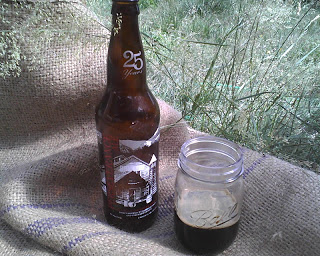

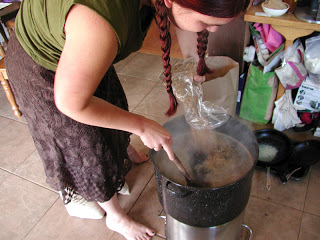
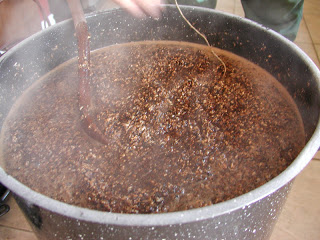
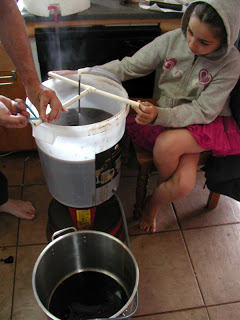
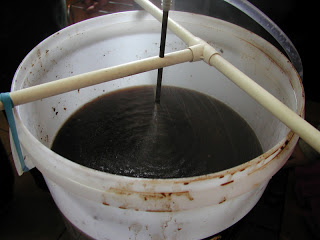
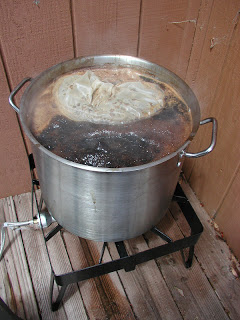
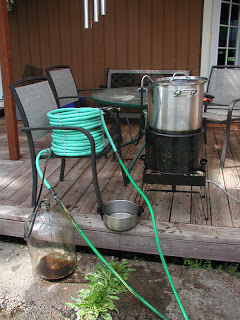
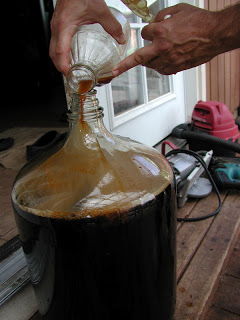
Leave a Reply